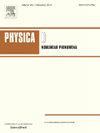Non-linearity and chaos in the kicked top
IF 2.9
3区 数学
Q1 MATHEMATICS, APPLIED
引用次数: 0
Abstract
Classical chaos arises from the inherent non-linearity of dynamical systems. However, quantum maps are linear; therefore, the definition of chaos is not straightforward. To address this, we study a quantum system that exhibits chaotic behavior in its classical limit: the kicked top model, whose classical dynamics are governed by Hamilton’s equations on phase space, whereas its quantum dynamics are described by the Schrödinger equation in Hilbert space. We explore the critical degree of non-linearity signifying the onset of chaos in the kicked top by modifying the original Hamiltonian so that the non-linearity is parameterized by a quantity . We find two distinct behaviors of the modified kicked top depending on the value of . Chaos intensifies as varies within the range of , whereas it diminishes for , eventually transitioning to a purely regular oscillating system as tends to infinity. We also comment on the complicated phase space structure for non-chaotic dynamics. Our investigation sheds light on the relationship between non-linearity and chaos in classical systems, offering insights into their dynamical behavior.
踢顶的非线性和混沌
经典混沌是由动力系统固有的非线性引起的。然而,量子映射是线性的;因此,混沌的定义不是直截了当的。为了解决这个问题,我们研究了一个在其经典极限下表现出混沌行为的量子系统:踢顶模型,其经典动力学由相空间上的汉密尔顿方程控制,而其量子动力学由希尔伯特空间中的Schrödinger方程描述。我们通过修改原始的哈密顿量来探索表明踢顶混沌开始的非线性临界程度,使非线性由一个量p参数化。我们发现修改后的踢顶根据p的值有两种不同的行为。当p在1≤p≤2范围内变化时,混沌加剧,而当p趋于无穷时,混沌减弱,最终过渡到纯规则振荡系统。我们还讨论了非混沌动力学的复杂相空间结构。我们的研究揭示了经典系统中非线性和混沌之间的关系,提供了对其动力学行为的见解。
本文章由计算机程序翻译,如有差异,请以英文原文为准。
求助全文
约1分钟内获得全文
求助全文
来源期刊

Physica D: Nonlinear Phenomena
物理-物理:数学物理
CiteScore
7.30
自引率
7.50%
发文量
213
审稿时长
65 days
期刊介绍:
Physica D (Nonlinear Phenomena) publishes research and review articles reporting on experimental and theoretical works, techniques and ideas that advance the understanding of nonlinear phenomena. Topics encompass wave motion in physical, chemical and biological systems; physical or biological phenomena governed by nonlinear field equations, including hydrodynamics and turbulence; pattern formation and cooperative phenomena; instability, bifurcations, chaos, and space-time disorder; integrable/Hamiltonian systems; asymptotic analysis and, more generally, mathematical methods for nonlinear systems.
 求助内容:
求助内容: 应助结果提醒方式:
应助结果提醒方式:


